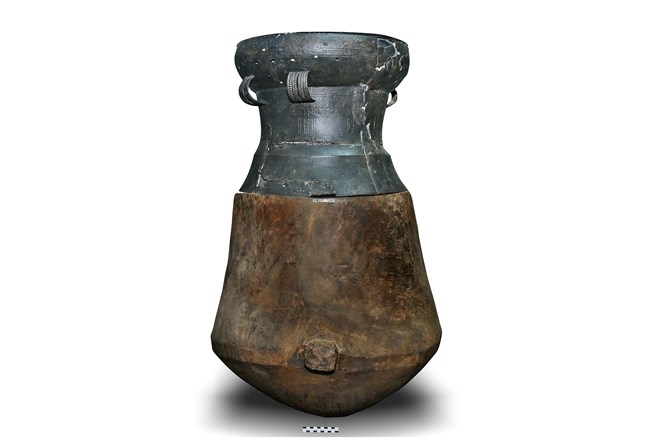
A wooden burial jar with bronze drum discovered in Phu Chanh commune in the southern province of Binh Duong has been recognised as a national treasure by Prime Minister Nguyen Xuan Phuc.
The wooden burial jar with
bronze drum was discovered in Phu Chanh commune of Binh Duong province (Photo:
VNA)
The object was uncovered in
late 1998 by Nguyen Van Cuong residing in Vinh Tan commune on a paddy field in
Phu Chanh commune, Tan Uyen town, at a depth of around 1.8-2.5m.
The wooden burial jar is about 61cm high with its mouth at a diameter of
46-50cm.
The bronze drum is close to 40cm high with a drumhead diameter of 47.5cm and
base diameter of 44cm.
The concentric drumhead has a 10-point star and it is simply decorated with
inverted "v” shaped patterns.
Do Thi Tien, Deputy Director of the Binh Duong Museum, said the artifact is
dated to the second and the first century BC (nearly 2,000 years ago).
This is a new type of tomb, the first to be discovered in the archaeological
history of Vietnam and the world, she added.
The use of a wooden jar with a bronze drum as a coffin is a new piece of
information while studying the lifestyles of ancient resident communities in
the southeastern region, Tien said.
Apart from the wooden burial jar, Binh Duong is preserving another national
treasure namely Doc Chua animal statue which was made around 3,000 years ago in
the shape of a four-legged animal with a long head, and found in Doc Chua
archaeological site.
So far, a total of 164 artifacts have been recognised as national treasures.
Source: VNA
The People’s Committee of Lac Son district held a ceremony on April 28 to receive the provincial relic certificate for the ancient rock carving site at Suoi Co stream, located in My Thanh commune.
A special music show titled "The country is in the fullness of joy” has been held at Hoa Binh Square in Hoa Binh city in celebration of the 50th anniversary of the liberation of the South and national reunification (April 30, 1975–2025).
The People's Committee of Lo Son commune, Tan Lac district, has organised the local annual traditional stream fishing festival on April 19 - 20.
As a land deeply intertwined with human history and Vietnam’s millennia-long journey of nation-building and defence, Hoa Binh is often revered for its epic tales and legends.
Residents of Hoa Binh boast a rich cultural identity, reflected in their unique language, traditional attire, customs, and folk melodies – described as "sweet as honey, clear as a mountain stream.”
Lac Son district’s Vu ban town held the 2025 Truong Kha temple festival on April 12–13 (the 15th–16th days of the third lunar month). Since its revival in 2019, the festival has been organised every three years, preserving valuable intangible heritage while meeting the community’s cultural and spiritual needs.



